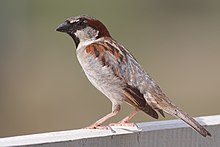Sparrow
| Sparrow | |
|---|---|
 |
|
| A male house sparrow | |
| Scientific classification | |
| Kingdom: | Animalia |
| Phylum: | Chordata |
| Class: | Aves |
| Order: | Passeriformes |
| Suborder: | Passeri |
| Infraorder: | Passerida |
| Superfamily: | Passeroidea |
| Family: |
Passeridae Rafinesque, 1815 |
| Genera | |
Passer
Petronia
Carpospiza
Hypocryptadius
Montifringilla
Sparrows are a family of small passerine birds, Passeridae. They are also known as true sparrows, or Old World sparrows, names also used for a particular genus of the family, Passer. They are distinct from both the American sparrows, in the family Emberizidae, and from a few other birds sharing their name, such as the Java sparrow of the family Estrildidae. Many species nest on buildings, and the house and Eurasian tree sparrows in particular inhabit cities in large numbers, so sparrows are among the most familiar of all wild birds. They are primarily seed-eaters, though they also consume small insects. Some species scavenge for food around cities and, like gulls or rock doves, will happily eat virtually anything in small quantities.
Generally, sparrows are small, plump, brown-grey birds with short tails and stubby, powerful beaks. The differences between sparrow species can be subtle. Members of this family range in size from the chestnut sparrow (Passer eminibey), at 11.4 centimetres (4.5 in) and 13.4 grams (0.47 oz), to the parrot-billed sparrow (Passer gongonensis), at 18 centimetres (7.1 in) and 42 grams (1.5 oz). Sparrows are physically similar to other seed-eating birds, such as finches, but have a vestigial dorsal outer primary feather and an extra bone in the tongue. This bone, the preglossale, helps stiffen the tongue when holding seeds. Other adaptations towards eating seeds are specialised bills and elongated and specialised alimentary canals.
...
Wikipedia
